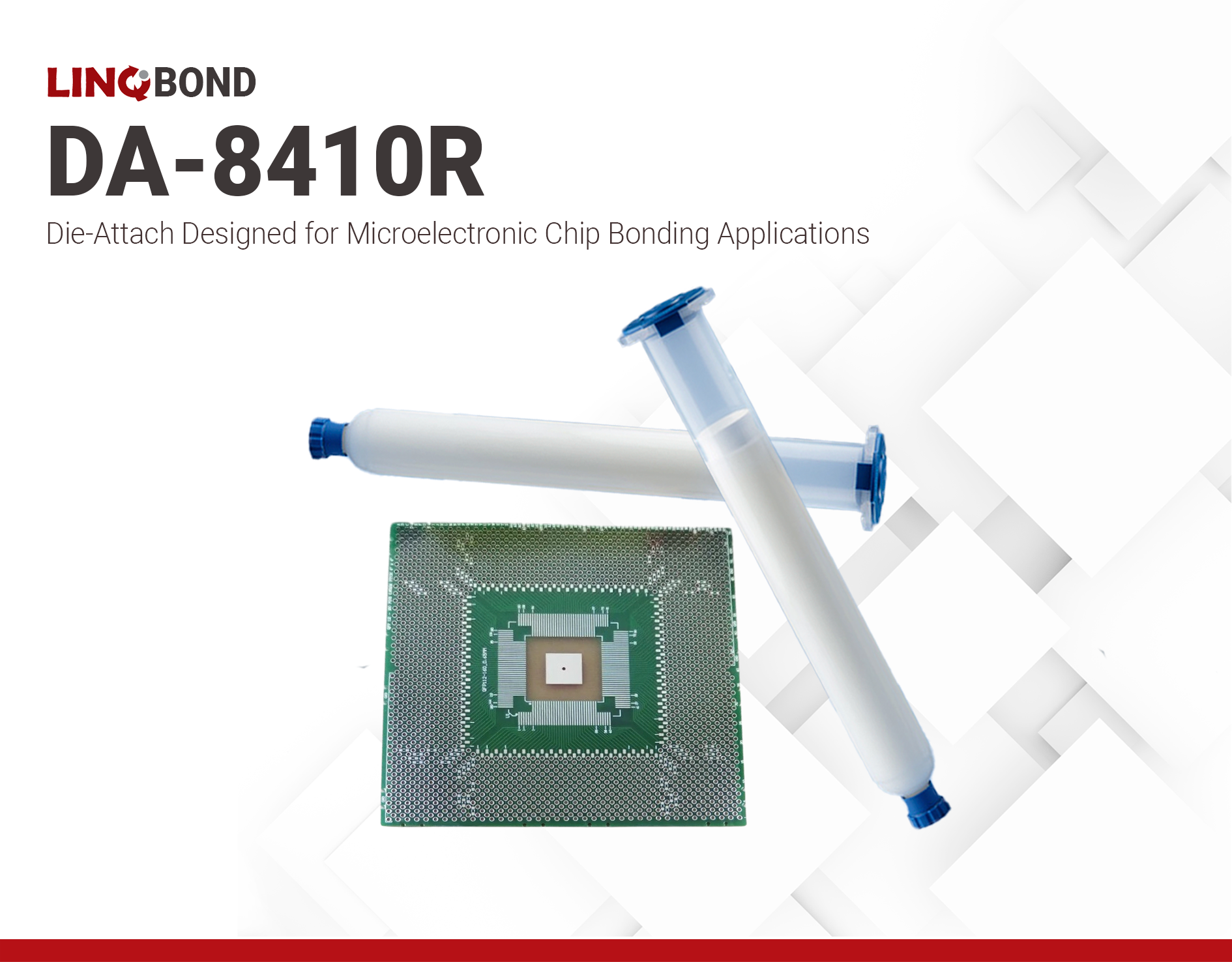LINQBOND DA-8410R | Die-Attach
- Low resin bleed out
- excellent adhesion and reiliability
- Stencil printable
Product Description
LINQBOND™ DA-8410R is a one-component, silver-filled, conductive die attach adhesive. It provides excellent adhesion for Si die on various substrates and lead frame finishes, including Ag-plated surfaces, bare Cu, PPF, and ceramics. It offers minimal resin bleed-out, ensuring superior workability.
Engineered for high reliability, LINQBOND™ DA-8410R meets MSL3 to MSL1 standards and is ideal for IC die attach applications across industries such as consumer electronics, industrial automation, IoT, smart devices, automotive, military, and aerospace.
Technical Specifications
| General Properties | |||||||
| |||||||
| Work life @25°C Work life @25°C Work life is the amount of time we have to work with a material until it is no longer able to be easily worked and applied on a substrate. It is based on the change in viscosity and it can rely on the application requirements. | 24 hours | ||||||
| Physical Properties | |||||||
| Thixotropic index Thixotropic index Thixotropic Index is a ratio of a material s viscosity at two different speeds in Ambient temperature, generally different by a factor of ten. A thixotropic material s viscosity will decrease as agitation or pressure is increased. It indicates the capability of a material to hold its shape. Mayonnaise is a great example of this. It holds its shape very well, but when a shear stress is applied, the material easily spreads. It helps in choosing a material in accordance to the application, dispense method and viscosity of a material. | 6 | ||||||
| Viscosity Viscosity Viscosity is a measurement of a fluid’s resistance to flow. Viscosity is commonly measured in centiPoise (cP). One cP is defined as the viscosity of water and all other viscosities are derived from this base. MPa is another common unit with a 1:1 conversion to cP. A product like honey would have a much higher viscosity -around 10,000 cPs- compared to water. As a result, honey would flow much slower out of a tipped glass than water would. The viscosity of a material can be decreased with an increase in temperature in order to better suit an application | 9250 mPa.s | ||||||
| Mechanical Properties | |||||||
| |||||||
| Thermal Properties | |||||||
| |||||||
| Glass Transition Temperature (Tg) Glass Transition Temperature (Tg) The glass transition temperature for organic adhesives is a temperature region where the polymers change from glassy and brittle to soft and rubbery. Increasing the temperature further continues the softening process as the viscosity drops too. Temperatures between the glass transition temperature and below the decomposition point of the adhesive are the best region for bonding. The glass-transition temperature Tg of a material characterizes the range of temperatures over which this glass transition occurs. | 63 °C | ||||||
| Thermal Conductivity Thermal Conductivity Thermal conductivity describes the ability of a material to conduct heat. It is required by power packages in order to dissipate heat and maintain stable electrical performance. Thermal conductivity units are [W/(m K)] in the SI system and [Btu/(hr ft °F)] in the Imperial system. | 20 W/m.K | ||||||
Additional Information
Curing Conditions
30 minutes ramp to 185 °C and hold for 90 minutes
These conditions serve as a reference only. Please establish the curing conditions based on the product's specific requirements.
Thawing Instructions
Remove the material from refrigeration and allow it to thaw completely before use.
Place syringes in a vertical position while thawing.
The thawing duration for a 5 cc to 10 cc syringe is 1 hour.
Store the thawed material in an airtight container at room temperature.
General Directions for Use
Do not refreeze the adhesive once it has been thawed to room temperature.
Wear appropriate protective equipment and minimize direct skin contact.
Refer to the Material Safety Data Sheet (SDS) before use for safety guidelines.
Storage and Handling
Store and transport at –40 °C. Keep away from fire and heat sources.



